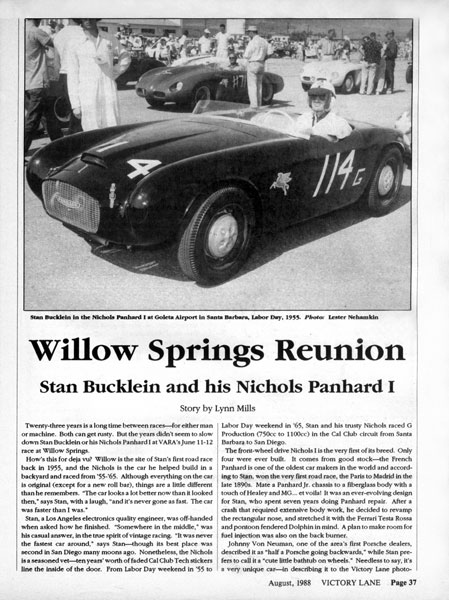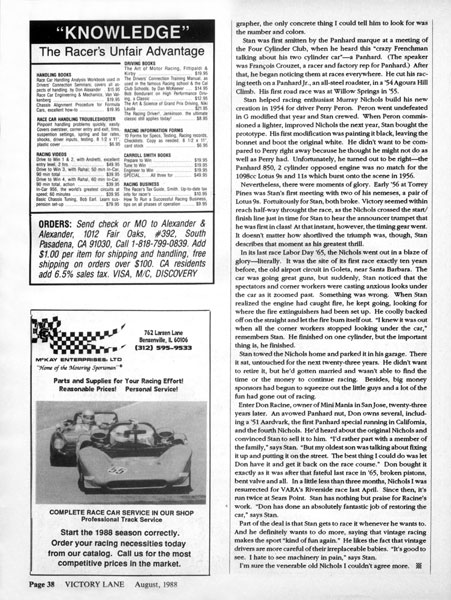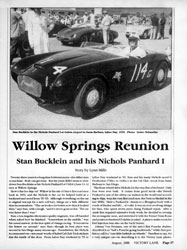

Willow Springs Reunion
Stan Bucklein and his Nichols Panhard IStory by Lynn Mills
Twenty-three years is a long time between races -- for either man or machine. Both can get rusty. But the years didn't seem to slow down Stan Bucklein or his Nichols Panhard I at VARA's June 11-12 race at Willow Springs.
How's this for deja vu? Willow is the site of Stan's first road race back in 1955, and the Nichols is the car he helped build in a backyard and raced from '55-'65. Although everything on hte car is original (except for a new roll bar), things are a little different than he remembers. "The car looks a lot better now than it looked then," says Stan, with a laugh, "and it's never gone as fast. The car was faster than I was."
Stan, a Los Angeles electronics quality engineer, was of-handed when asked how he finished. "Somewhere in the middle," was his casual answer, in the true spirit of vintage racing. "It was never the fastest car around," says Stan -- though its best place was second in San Diego many moons ago. Nonetheless, the Nichols is a seasoned vet -- ten years' worth of faded Cal Club Tech stickers line the inside of the door. From Labor Day weekend in '55 to Labor Day weekend in '65, Stan and his trusty Nichols raced G Production (750cc to 1100cc) in the Cal Club circuit from Santa Barbara to San Diego.
The front-wheeled drive Nichols I is the very first of its breed. Only four were ever built. It comes from good stock - the French Panhard is one of the oldest car makers in the world and according to Stan, won the very first road race, the Paris to Madrid in the late 1890s. Mate a Panhard Jr. chassis to a fiberglass body with a touch of Healey and MG... et voila! It was an ever-evolving design for Stan, who spent seven years doing Panhard repair. After a crash that required extensive bodywork, he decided to revamp the rectangular nose, and stretched it with the Ferrari Testa Rossa and pontoon fendered Dolphin in mind. A plan to make room for fuel injection was also on the back burner.
Johnny Von Neuman, one of the area's first Porsche dealers, described it as "half a Porsche going backwards," while Stan prefers to call it a "cute little bathtub on wheels." Needless to say, it's a very unique car -- in describing it to the Victory Lane photographer, the only concrete thing I could tell him to look for was the number and colors.
Stan was first smitten by the Panhard marque at a meeting of the Four Cylinder Club, when he heard this "crazy Frenchman talking about his two cylinder car" -- a Panhard. (The speaker was Francois Crouzet, a racer and factory rep for Panhard.) After that, he began noticing them at races everywhere. He cut his racing teeth on a Panhard Jr., an all-steel roadster, in a '54 Agoura Hill Climb. His first road race was at Wilow Springs in '55.
Stan helped racing enthusiast Murray Nichols build his new creation in 1954 for driver Perry Peron. Peron went undefeated in G modified that year and Stan crewed. When Peron commissioned a lighter, improved Nichols the next year, Stan bought the prototype. His first modification was painting it black, leaving the bonnet and boot the original white. He didn't want to be compared to Perry right away because he thought he might not do as well as Perry had. Unfortunately, he turned out to be right -- the Panhard 850, 2-cylinder opposed engine was no match for the 1098cc Lotus 9s and 11s which burst onto the scene in 1956.
Nevertheless, there were moments of glory. Early '56 at Torey Pines was Stan's first meeting with two of his nemeses, a pair of Lotus 9s. Fortuitously for Stan, both broke. Victory seemed within reach halfway through the race, as the Nichols crossed the start/finish line just in time for Stan to hear the announcer trumpet that he was first in class! At that instant, however, the timing gear went. It doesn't matter how shortlived the triumph was, though. Stan describes that moment as his greatest thrill.
In its last race Labor Day '65, the Nichols went out in a blaze of glory -- literally. It was the site of its first race exactly ten years before, the old airport circuit in Goleta, near Santa Barbara. The car was going great guns, but suddenly, Stan noticed that the spectators and corner workers were casting anxious looks under the car as it zoomed past. Something was wrong. When Stan realized the engine had caught fire, he kept going, looking for where the fire extinguishers had been set up. He coolly backed off on the straight and let the fire burn itself out. "I knew it was out when all the corner workers stopped looking under the car," remembers Stan. He finished on one cylinder, but the important thing is, he finished.
Stan towed the Nichols home and parked it in his garage. There it sat, untouched for the next twenty-three years. He didn't want to retire it, but he'd gotten married and wasn't able to find the time or the money to continue racing. Besides, big money sponsors had begun to squeeze out the little guys and a lot of the fun had gone out of racing.
Enter Don Racine, owner of Mini Mania in San Jose, twenty-three years later. An avowed Panhard nut, Don owns several, including a '51 Aardvark, the first Panhard special running in California, and the fourth Nichols. He'd heard about the original Nichols and convinced Stan to sell it to him. "I'd rather part with a member of the family," says Stan. "But my oldest son was talking about fixing it up and putting it on the street. The best thing I could do was let Don have it and get it back on the race course." Don bought it exactly as it was aftre that fateful last race in '65, broken pistons, bent valve and all. In a little less than three months, Nichols I was resurrected for VARA's Riverside race last April. Since then, it's run twice at Sears Point. Stan has nothing but praise for Racine's work. "Don has done an absolutely fantastic job of restoring the car," says Stan.
Part of the deal is that Stan gets to race it whenever he wants to. And he definitely wants to do more, saying that vintage racing makes the sport "Kind of fun again." He likes the fact that vintage drivers are more careful of their irreplaceable babies. "It's good to see. I hate to see machinery in pain," says Stan.
I'm sure the venerable old Nichols I couldn't agree more.


